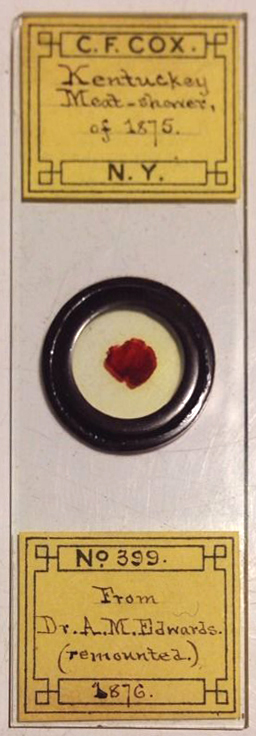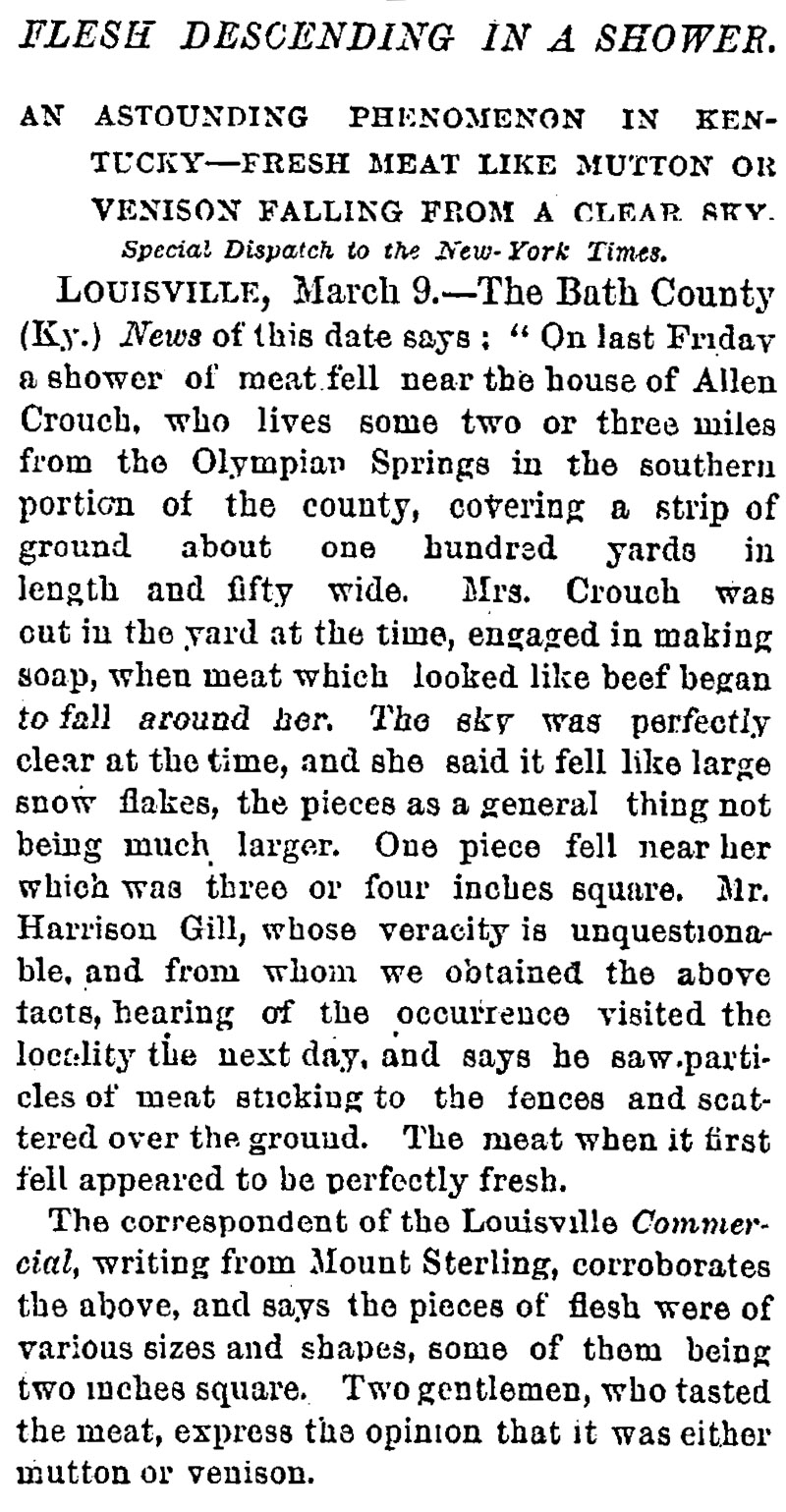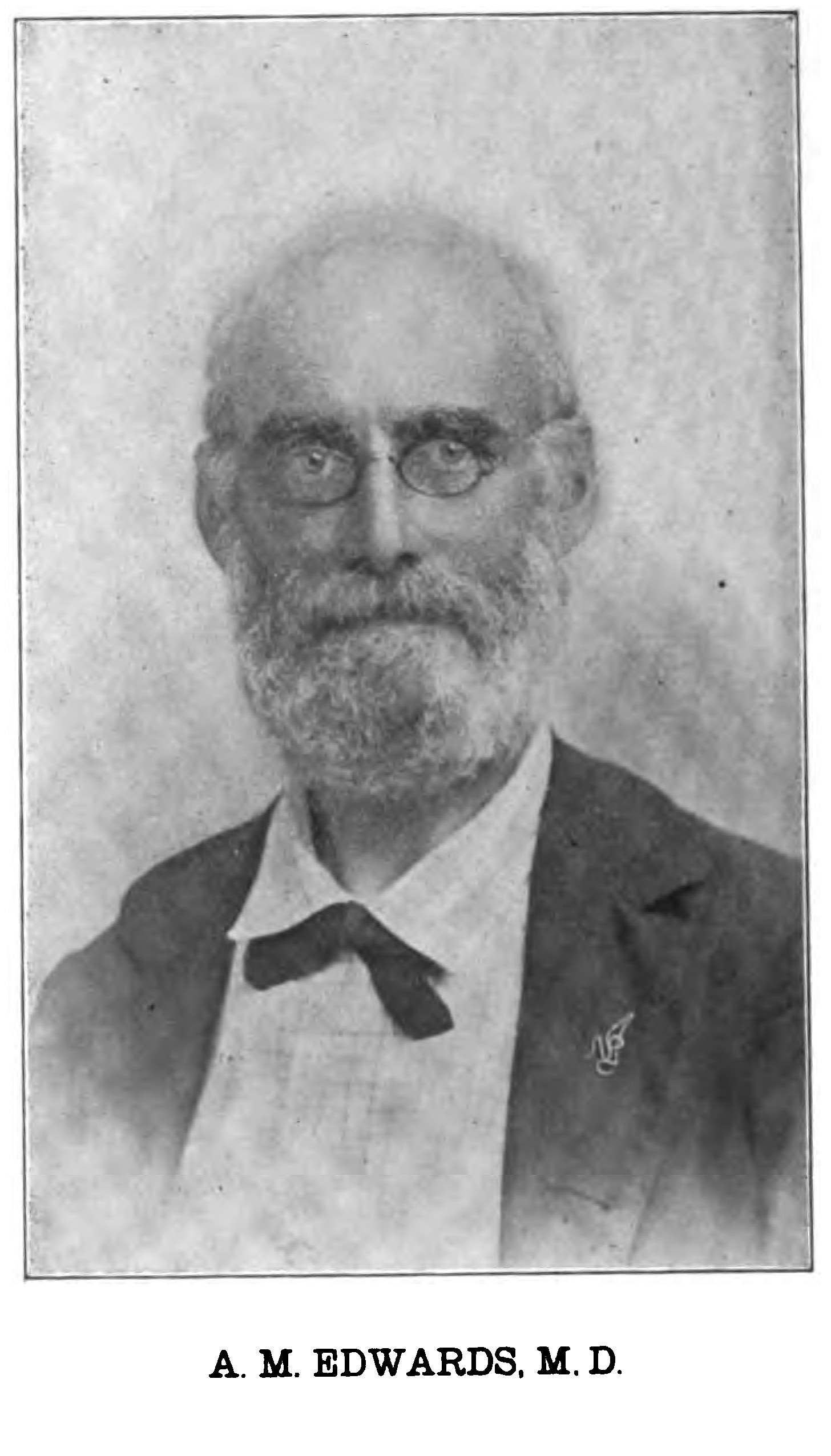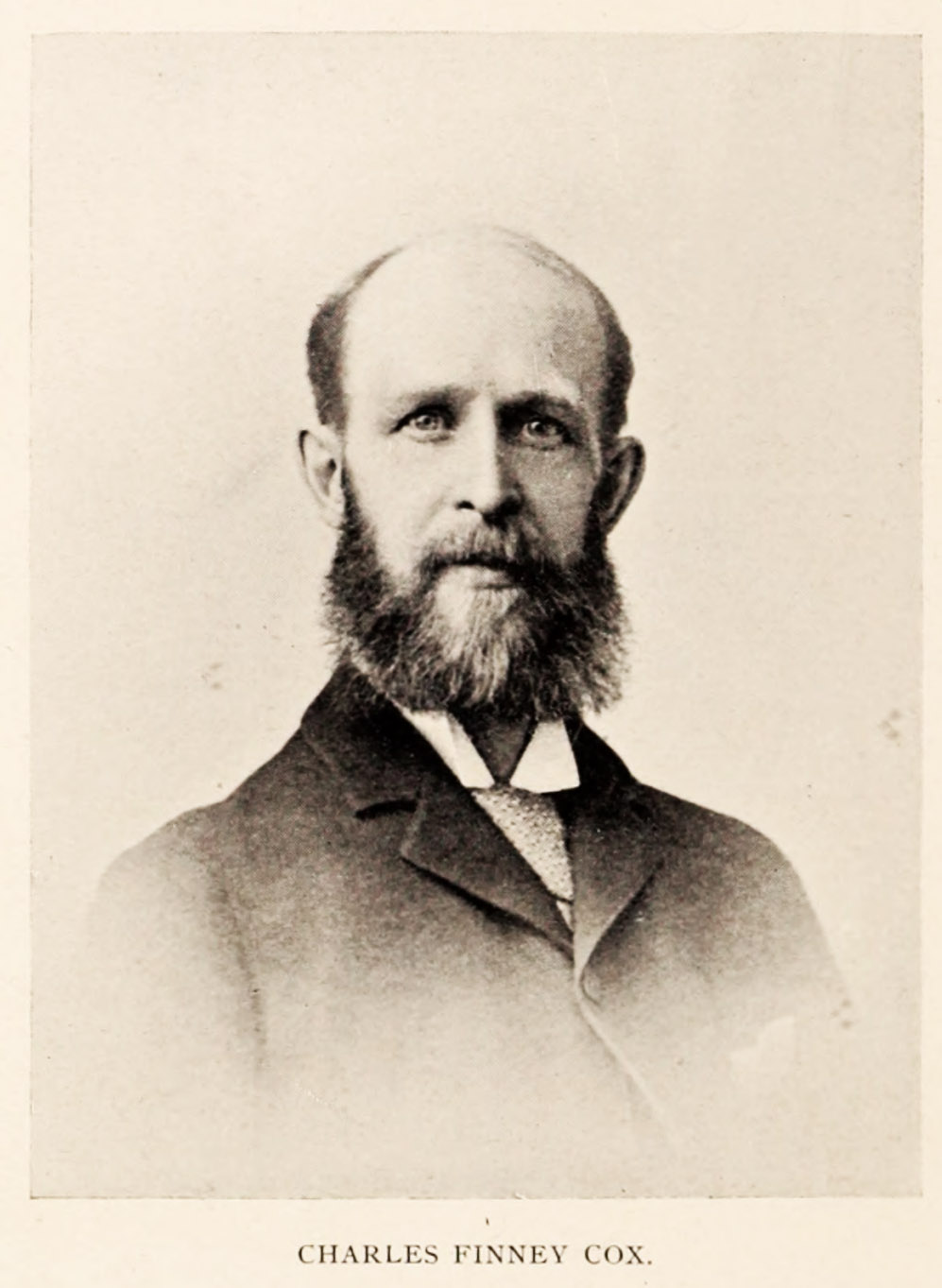The Kentucky “Meat Shower” of 1876
by Brian Stevenson
last updated August, 2014
A
microscope slide recently appeared at auction that has a very unusual history,
or rather, a very unusual specimen. The slide is labeled “Kentucky Meat-shower of 1876”, and carries a piece of animal flesh
(Figure 1).
According
to The New York Times, on March 9 of
that year, a considerable number of pieces of meat fell from the clear sky.
Most were the size of the mounted specimen, although one was 3-4 inches square.
An area of ground 100 by 50 yards was covered with meat pieces. Two
overly-curious men reported that the meat tasted like mutton or venison (Figure
2).

Figure 1.
Microscope slide of a remnant of the Kentucky Meat Shower of 1876. The specimen was originally mounted by Arthur M. Edwards, and remounted by Charles Finney Cox (1846-1912). The slide was found in a collection in Ohio, USA, probably via Cox’s brother Jacob Dolson Cox (1828-1900), who lived in Ohio from ca. 1851 onward. Image adapted from an internet auction site.

Figure 2.
The March 9, 1876, New York Times story on the Meat
Shower.
Needless
to say, there was considerable speculation about the origin of the falling
meat, including whether it was truly animal tissue. Dr. Arthur Mead Edwards, of the Newark
(New Jersey) Scientific Association and Microscopist to the Geological Survey
of New Hampshire, gathered samples from the Meat Shower and used microscopic
analyses to determine that the substance truly was animal flesh. He published
his findings in the July 22, 1876 issue of Scientific American, “Sir: In your Supplement for July 1st is an article, taken from the ‘Sanitarian’, on the Kentucky meat-shower, and, introducing the article, you
express an opinion that we have therein a solution of the question as to what
the substance constituting the meat-shower was, in
Mr. Brandeis' assertion that it consisted of masses of nostoc, a low form of
vegetable existence. As the public seems to be still interested in the matter,
and as, apparently, they have not yet learned what it really is, permit me say
a few words thereon. We have in the city of Newark, N.J., an active, wide-awake
organization known as the Newark Scientific Association, at the meetings of
which novel scientific matters are discussed and sifted. At one of our
meetings, for the first time, the true solution of Mr. Edison's so-called
‘etheric force’ took place; and at our meeting in March last the Kentucky meat-shower was discussed, and at that time I
made a communication reviewing what was known with regard to so-called showers
of meat, blood, and colored matters generally. At
that time, and before I had seen any specimens from Kentucky,
I expressed an opinion that it would turn out to be nostoc. When, then,
I saw Mr. Brandeis' communication, I felt convinced that he had solved the
problem, and knowing him well, I called on him to see if he could give me a
specimen of the original article. He kindly placed his whole supply in my
hands, and informed me that it had been received from Prof. Chandler, who gave
it to a physician in Brooklyn, who in turn gave it to him, Mr. B. Soon after,
Dr. Allan McLane Hamilton published a letter in the ‘New York Medical Record’, wherein he said that
he had received a piece of the Kentucky Shower from
Prof. Chandler, and a microscopic examination of it by himself and Dr. J.W.S.
Arnold revealed the fact that it consisted of lung tissue either from a human
infant or a horse, the structure of the organ in these two cases being very
similar. At once I called on Dr. Hamilton, and he likewise placed his specimens
in my hands, at the same time in forming me that two
morsels of the shower had been sent from Kentucky to the editor of the ‘Agriculturist’; that gentleman placed them in the hands of Prof.
Chandler. One went to Dr. Hamilton, the other to Brooklyn, and eventually into
the hands of Mr. Brandeis. So I evidently had the whole matter in my
possession. On examination I found Dr. Hamilton's specimen to be, as he stated,
lung tissue, in one portion of which cartilage was to be seen beautifully
exhibited. Mr. Brandeis' specimen, when examined by means of the microscope,
turned out to be lung tissue also, but not in as good a state of preservation
as the first mentioned. Soon thereafter I was shown by Prof. J. Phin, of the ‘American Journal of Microscopy’, a
prepared specimen sent from Kentucky to Mr.
Walmsley, of Philadelphia, which was undoubtedly striated muscular fibre. And
subsequent thereto he showed me another specimen sent to him by Mr. A.T.
Parker, of Lexington, Ky., which was also striated muscular fibre. Being
determined to follow the matter up, I wrote to Mr. Parker, and he very kindly
sent me three specimens, two in the natural state as they fell, and one
prepared and mounted for the microscope. The last-named consists entirely of
cartilage; one of the others is likewise a mass of cartilage, while the
remaining portion shows a few striated muscular fibres, along with what appears
to be dense connective tissue, but in such a condition that its exact character
can not be well made out. I am promised further specimens and information by
Mr. Parker, who has been unsparing in his endeavors to elucidate the mystery,
whilst he has been at the same time extremely liberal in the matter of
distributing specimens. So much for the facts. Every specimen I have examined
has proved to be of animal origin, showing that the
Kentucky shower was a veritable ‘meat’ shower. As to whence it came I have no theory. Mr.
Parker informs me that the favorite theory in the locality is, that it
proceeded from a flock of buzzards who, as is their custom, seeing one of their
companions disgorge himself, immediately followed suit. In fact, such an occurrence
has been actually seen to occur, so that it would seem that the whole matter is
capable of a reasonable and simple explanation, and we may expect to hear of
similar downfalls in other localities”.
Parker’s hypothesis is the most reasonable and widely accepted origin of the meat
shower. Vultures are known to disgorge the contents of their crops when
panicked, as a defense mechanism and, possibly, to lighten themselves for fast
escape. As a resident of central Kentucky, the author of this essay can attest
that that large flocks of vultures are very common during March. Fortunately, I have yet to be vomited upon by them.

Figure 3.
Arthur Mead Edwards (1836-1914). Adapted from The American Monthly Microscopical Journal, July, 1896.

Figure 4.
Charles Finney Cox (1846-1912), from an 1893 biography in "New York, the Metropolis: Its Noted Business and Professional Men".
Resources
Edwards, A. Mead (1876) The Kentucky meat-shower, Scientific American, Vol. 2, page 473
Feinstein, Julie (2011) Turkey Vulture, in Field Guide to Urban WildlifeStackpole
Books, Mechanicsburg, Pennsylvania, pages 134-138
Landis-Foster-Hutton Family Tree (accessed August, 2014) information on the life of A.M. Edwards, http://landisfamilytree.blogspot.com/2010_01_01_archive.html
The New York Botanical Garden Archives and Manuscripts: Charles Finney Cox Papers (accessed August, 2014) http://www.nybg.org/library/finding_guide/archv/cox_ppf.html
New York Times (1876) Flesh descending in a shower, an astounding phenomenon in Kentucky – fresh meat like mutton or venison falling from a clear sky, March 9
Smiley, C.W. (1896) Sketch of the life of Arthur Mead Edwards, M.D., The American Monthly
Microscopical Journal, Vol. 18, pages 227-228
Sprague, John F. (1893) New York, the Metropolis: Its Noted Business and Professional Men, New York Recorder, pages 200-201



